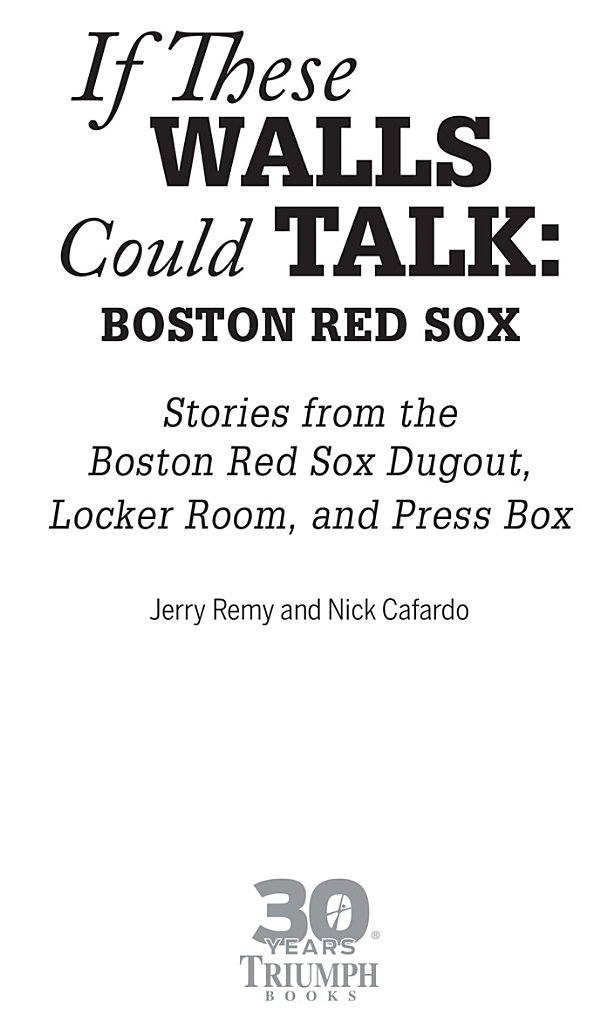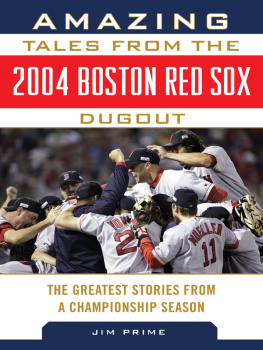
~
To my grandchildren, Dominik and Arianna, whom I love more than anything in this world. They are the joy of my life and give me incredible strength and courage.
J.R.
Contents
Foreword by Sean McDonough
Over the 35 years since I graduated from Syracuse (aka The Harvard of Central New York) and embarked on a career in sports broadcasting, I have kept a list of the names of every analyst, producer, director, sideline reporter, and studio host with whom I have worked on the local and national level. In the four major sports alone, the number of different color commentators is 104 (baseball 30, football 25, basketball 35, and hockey 14). When you add golf, tennis, soccer, lacrosse, bobsled, and luge, the number is more than 160. Some were much more talented than others. Some were much easier to be around than others. With very few exceptions (and the list of names of the exceptions will wait for my book), I have enjoyed working with each of them. But the pairing I will always view as special, and unique, is my nine-year partnership with Jerry Remy in the Red Sox television booth.
Jerry and I started in the Red Sox booth, though not together, in 1988. I was paired alongside long-time analyst and former Red Sox catcher Bob Montgomery in the WSBK-TV38 booth. Jerry joined Red Sox legend Ned Martin on the NESN cablecasts. For me, at age 25, it was the fulfillment of my childhood dream and an opportunity I embraced with tremendous excitement and gratitude. For Jerry, not far removed from a major league playing career, it was a way to stay in the game and continue to make a living. I got the sense it was an opportunity he undertook with great trepidation about whether or not he would be able to do the job.
I worked with Monty for eight years. During that time, I got to know Jerry as we traveled together on the road with the Red Sox. I didnt know him well. By his own admission, very few people know Jerry well. But as I listened to him talk and tell stories on buses and airplanes, and in restaurants and hotels, I knew that I liked him. And I was convinced that there was much more to his personality, and his broadcasting ability, that had not come out to the NESN audience.
Starting with the 1996 season, the over-the-air telecasts moved to WABU-TV, and its station management, in conjunction with the Red Sox and NESN, decided that Jerry would be the analyst on all of the TV games. While I felt bad for Monty, who was losing a job that he enjoyed and at which he worked hard, I was excited for the opportunity to work with Jerry.
I did not consciously enter into this new partnership with the goal of dragging out more of Jerrys personality, in part because I didnt know if he would be comfortable going there. But I knew that I would continue to do what I had always done, which is to engage the analyst in conversation (a must on baseball broadcasts during which there is so much dead time between pitches) and to ask the questions I think the viewers are asking as they watch. I didnt know how Jerry would respond, but I was hopeful and optimistic that the viewers and I would see more of the Jerry I had seen off the air. It didnt take long before we did.
Perhaps because we had spent eight years around each other, and respected and liked each other before we ever sat in a booth together, our strong on-air chemistry and rapport developed quickly. I think Jerry knew and trusted that I had his best interests at heart. If need be, I wanted to help lead him into conversations about game strategy, individual player skill, lessons learned from his own playing days, and anything else that might be appropriate given the game situation we were watching and analyzing. And when the game got one-sided and the audience wasnt hanging on every pitch, I hoped that Jerry would join me in trying to keep it interesting and fun by talking about other things that sometimes had little or nothing to do with what was happening on the field. Boy, did he ever.
These became some of my favorite moments, and now memories, of our time together. I believe that most, but not all, of our viewers enjoyed them, too. For Jerry and me, they came to be known as Inane Banter. We had received a letter from an angry woman who implored us to stick to the game and let us know very clearly that she hated it when we drifted off into our inane banter. I read her letter on the air and, from that point forward until the joke got old, we would warn the author of the letter that we were about to go off on a tangent by flashing an Inane Banter Warning graphic in the corner of the screen. It was in those moments when Jerrys personality came shining through, and Red Sox Nation began to see the sense of humor and storytelling ability that would play a big part in his becoming a Red Sox legend. As Jerry grew comfortable sharing more of himself, the moments happened more often. From his updates on Days of Our Lives to the emergence of his close friendship with Wally the Green Monster, it was impossible to predict where Jerry might take us. But Red Sox Nation discovered that Jerry was interesting and funny, and we wanted more.
One of my goals was to make Jerry laugh so hard that he would take his headset off, or at least depress the cough button that would kill his microphone. There were many instances when that happened, or that he said something so funny that I, or both of us, went several pitches without saying anything. I remember our fantastic, and exasperated, producer Russ Kenn saying, This is really professional, guys in our ears after we killed our mics and laughed as the audience heard nothing from us while several pitches passed by. Often, we just went ahead and laughed, snorted, or snickered on the air. Is there a laugh that is better known in New England than Jerrys?
One night, we were in Cleveland as the Red Sox were playing the Indians. Justin Speier, a relief pitcher, came into the game for the Tribe. As I thumbed through the Indians media guide, I noticed that Speier had pitched collegiately at Nicholls State in Louisiana. I knew more than I should about Nicholls State, because its basketball team had played in an NCAA tournament game I called for CBS. So, I told Jerry, and our audience, that Nicholls State was named after Francis T. Nicholls, a brigadier general in the Civil War who lost his left arm and foot in battle. When I mentioned that Nicholls returned to Louisiana to run for governor using the slogan Vote for the REST of Me, Jerry lunged for the cough button. When I offered my opinion that this was probably a better slogan option than I would give an arm and a leg to be governor, Jerry just about fired his headset off the wall. There was a long stretch during which neither of us said a word. (Additional historical footnote: the slogan was successful as Nicholls was twice elected governor of his home state.)
One night, at Fenway Park, we had an in-game visit from Judith Sheindlin, better known as Judge Judy, whose popular arbitration-based courtroom reality show aired on our station and made her one of the highest-paid people in the history of American television. We had a nice on-air chat. It was in what transpired immediately after that visit where Jerrys ability to be funny spontaneously was on full display. After Judy and her grandsons left our booth and returned to their seats, we were informed by highly reputable booth personnel that the famed jurist and her grandsons departed our booth with a box of our Dunkin Donuts. Our crew took a shot of Judy and the boys, which presented clear video evidence that they were eating from a box of Dunkin Donuts that we, and our unimpeachable eyewitnesses who watched them abscond with the delectable treats from the booth, considered stolen. A hilarious (at least to Jerry and me) conversation, that was clearly not intended to be taken seriously, about the possibility of legal action against Americas best-known judge, ensued. It was relayed to us that Judys defense was that she had asked if she could take the Dunkin Donuts before removing them from the booth. We were also told that the judge was none too pleased about our false accusations. (Who knew, by watching her show, that Judy had a temper?) Anyway, we were pretty sure our evidence, and the testimony of our eyewitnesses/audio engineers/stage managers, would have held up in any court of law, including our personal favorite, The Peoples Court , in front of the all-time greatest TV Judge, the late, great Joe Wapner. But, fearful of a countersuit by Judy for trivial things like slander/libel/damage to reputation, etc., Jerry and I offered a completely sincere on-air apology to Judge Judy. At least, thats how I recall it. Now, fearful that the statute of limitations might not have run out, I offer another equally sincere apology, on behalf of Jerry and me, on these pages. Part of the appeal of Jerrys humor is that he is not afraid to press the boundaries of appropriateness and is not impacted by the threat of inadvertently offending someone (or of legal action), as the previous examples demonstrate (although I deserve any blame for inappropriateness relative to Gov. Nicholls).




